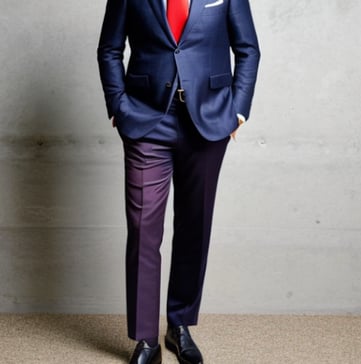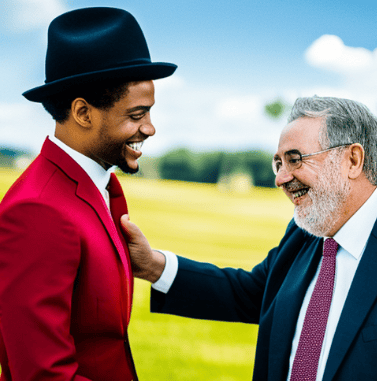Body Language Secrets for Men: A Guide to Being a Confident Gentleman
How to Use Body Language to Convey Gentlemanly Qualities: A Guide for Men
GENTLEMANLY HABITS
By John Smith
5/8/20235 min read
The way we present ourselves through our body language affects how others perceive us and is a crucial component of communication.
Being aware of your body language and using it in a situation-appropriate manner is key for gentlemen.
Posture
In terms of body language, posture is one of the most crucial elements.
A gentleman should maintain a relaxed posture and stand up straight at all times, as this exudes confidence and self-assurance.
An unconfident or uninterested posture can be communicated by slouching or drooping.
Contrarily, conceited posture is characterized by an excessive, overly confident, even arrogant stance that communicates superiority and a lack of humility. Someone who is extremely self-absorbed and projects an arrogant posture may also have the attitude that they are superior to others or are trying too hard.
Furthermore, proper posture can aid to improve breathing and generate a sensation of peace and relaxation. Physical activity, particularly workouts that focus on strengthening the core and upper body, can assist in improving posture by increasing muscle tone and strength.




Confident (little grin, relaxed, welcoming)
Arrogant (chin up, shoulders up, restricted)
Eyes
Eye contact is another key aspect of body language.
When chatting with others, a gentleman should make eye contact to convey that he is paying attention and involved in the conversation.
On the other hand, avoiding eye contact might be regarded as dishonesty or a lack of confidence.
However, it is crucial to be conscious of cultural variations, as some cultures see direct eye contact as a sign of disrespect.
Also, some individuals may be uncomfortable with lengthy eye contact, and it's vital to respect that.
A sincere grin, which includes smiling with the eyes, can be a wonderful approach to connecting with others and establishing rapport with them. Making the other person feel at ease and more comfortable can be helpful.
In cases where you do not want to talk with a person, try avoiding or breaking eye contact. You can achieve this by averting your gaze, avoiding eye contact, or breaking eye contact as soon as it starts.




Smiling with the eyes
Facial expressions
The way your face looks is another important aspect of body language. A gentleman should be mindful of his facial expressions and know how to convey his feelings through them.
A frown might imply melancholy or disapproval, whereas a grin can imply friendship and warmth. being conscious of one's facial expressions and making sure they fit the circumstance or the conversation's tone.
Gestures
Another crucial component of body language is gestures. Men should use thoughtful, appropriate gestures since they can serve to accentuate or clarify their speech. For example, pointing might imply emphasis, whereas a hand gesture can signify an inquiry or request for an explanation.
However, it is also vital to be conscious of cultural variations, as some gestures can have different meanings in different cultures. Act out various scenarios or practice motions and mimics in front of the mirror. You can communicate your disinterest in a discourse by using a neutral or closed-off facial expression. This can be accomplished by maintaining a straight expression and refraining from smiling or frowning.
Proxemics
The utilization of space, or proxemics, is another key part of body language. A gentleman should be conscious of the amount of space he occupies and how others may view him.
Standing too close to someone, for example, might make them feel uneasy while standing too far away can show a lack of interest or involvement. Paying attention to a person's body language and nonverbal indicators such as posture, eye contact, facial expressions, touch, and vocal cues can help you determine if they want to be closer or farther away.


Legs
A gentleman's legs should be used as body language to convey confidence, assertiveness, and respect. This entails standing tall and with proper posture (shoulders back, chest out). This conveys confidence and assertiveness. Furthermore, adopting an open stance, with the legs spread and facing the individual, demonstrates that the guy is approachable and open to discussion. This is important in scenarios like business meetings or social gatherings.
Touch
Last but not least, touch is a significant component of body language. Men should use touch sensibly and be cognizant of the signals it conveys.


For instance, a handshake might imply respect and trust, but a slap on the back can imply support or congratulations.
Although some people might not be at ease with particular sorts of contact, it's crucial to be conscious of cultural and individual variances around touch. Touch is valued more highly in some cultures, such as those of the United States and Northern Europe, and is frequently used among close friends, family members, or love partners. Touching strangers or acquaintances is less common. Physical contact is less prevalent in some Asian cultures and may be perceived as intrusive or rude. During talks, people may avoid touching each other or restrict touch to a handshake or bow.
Physical contact, on the other hand, is a significant part of communication in some other cultures, such as Latin American and Mediterranean civilizations, and is utilized regularly in social interactions. People may touch, embrace, or pat each other on the back while conversing.
Closing thoughts
Overall, body language is a crucial part of communication and gentlemanliness, and it takes time and effort to master the essential techniques.
You may enhance your body language and create deeper, more meaningful connections by being conscious of your posture, eye contact, facial expressions, gestures, proxemics, and touch and employing them appropriately.
It's critical to be conscious of cultural variations and individual preferences as well since these factors can significantly affect how the message is perceived.
A gentleman should also be aware of social cues and adapt their body language accordingly. For example, they should maintain a respectful distance when standing or sitting, mimic the other person's posture or gestures, or adopt an open, relaxed stance to show that they are at ease and prepared for a conversation.
A gentleman may communicate efficiently and politely by being conscious of both his own body language and that of others and by making the necessary modifications.

